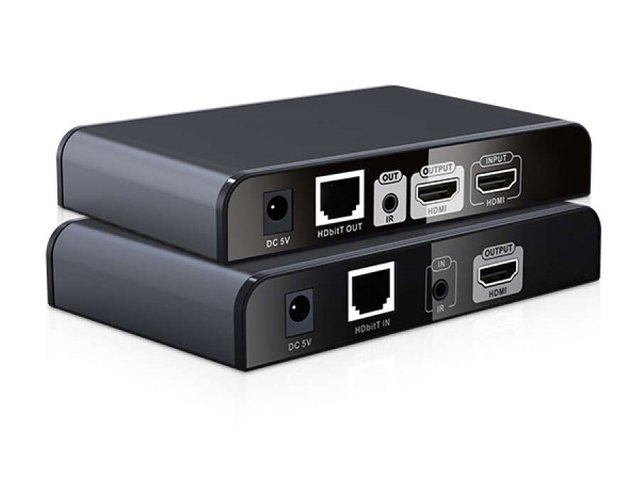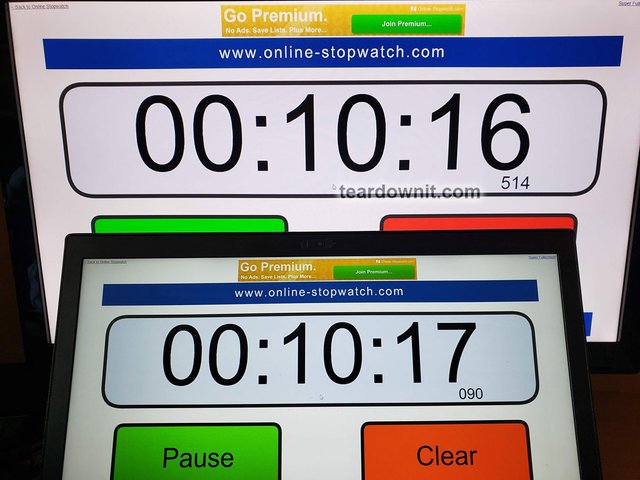Earlier in the post link, we tested the Lenkeng LKV373 kit and verified that the delay was insignificant - 0.067 seconds.
We recently examined the Lenkeng LKV383PRO over-IP extender kit, which upset us. Let's look into what the problem is.
What's the difference between a regular twisted-pair HDMI extender and an over-IP
- Regular twisted-pair HDMI extender. The transmitter and receiver are connected to each other by a single piece of twisted pair (usually 130 to 330 feet). The twisted pair is used exclusively as some transport for specific signals. Video is transmitted in its original quality and without delay in this case.

- Over-IP HDMI extender. Transmitter and receiver work on IP protocol, which means they can be connected to a local Ethernet network. The transmission range is limited to IP protocol, i.e., 330 feet. The range can be increased if a switch is connected between the transmitter and receiver in the middle. In this case, the video usually shows signs of slight compression and is transmitted with a small but visible delay.

An additional undeniable benefit of over-IP devices is the ability to connect additional receivers that connect to a LAN switch. They will display video from a single transmitter on that LAN without additional settings. Similar connection schemes can connect multiple TVs in a store to display promotional information.

When choosing an extender of the first type, everything is simple. You must decide on the maximum video resolution (FullHD or 4K) and video transmission range.
When choosing an extender of the second type, in addition to resolution and range, you need to pay attention to two more essential parameters: compression and delay.
HDMI over-IP extender image compression
Most low-cost HDMI over-IP extenders use video compression. An HDMI transmitter receives video at its input, encodes it with a specific codec (MPEG2, MPEG4, or other), and transmits it to the LAN network. The receiver receives this signal, decodes it, and outputs the video to the HDMI output. With this method of transmission, we may see a slight loss of image quality. At the same time, image deterioration can be observed only in some use cases. For example, when transmitting laptop desktop, showing documents. In this case, we can see a slight distortion of small details (letters, punctuation marks). When sending classic video content, image compression is difficult to see.
More expensive HDMI over-IP extenders use uncompressed transmission. Unfortunately, this device is still rare due to its high cost.
HDMI over-IP extenders video transmission delay
This parameter depends directly on the compression of the image. It takes time to encode and decode the image. Plus, more time for transmitting data packets in the IP network.
We experimented with Lenkeng LKV373 earlier and received an average delay of 0.067 seconds with a direct twisted pair connection without a switch. We considered this delay to be insignificant.


Recently we came across an older model of the same manufacturer - Lenkeng LKV383PRO. The main differences from the younger model are the transmitter's HDMI pass-through output and the IR signal reverse transmission.
When connecting it, we noticed a delay in video transmission, which was very noticeable. This upset us.
Having measured the delay, we got an average result of 0.5 seconds, which sometimes decreased to 0.2 seconds. Recall that the younger model managed in the same conditions for a relatively stable 0.067 seconds.


Instead of a conclusion
Who does NOT care? Let's say you have a TV receiver in one room and a TV in another. There are LAN outlets near the TV and the receiver. You can easily buy this set. It allows you to transmit video from one room to another. You can also remotely control the IR remote control of your receiver from the side of your TV. You won't notice any lag at all. Only a slight lag when scrolling through the menus.
Who cares? Suppose you are in a bar with a remote TV or projector connected to your laptop. You decide to output the sound separately to a sound amplification system connected directly to the computer. In this case, you will get mismatched audio and video. If there is a delay of 0.067 seconds, this can be neglected. At a delay of 0.5 seconds, it is very noticeable and annoying.
Unfortunately, you will not find this parameter in the technical specifications of the devices. It can be obtained only by experience after purchase. For most users, these two parameters will be optional. But someone can expect an unpleasant surprise.